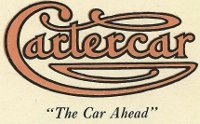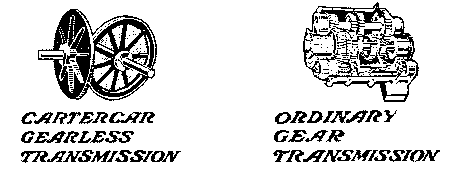| Why is it called the Cartercar? |
It was named after its inventor - Byron
J. Carter. Note that it is "Cartercar," not "Carter
Car," although you will see it written as "Carter Car" in
many places.
|
| What is different about the Cartercar? |
It has a "friction-drive" transmission. There are
no gears in the transmission, just two wheels that touch each
other. Changing where the wheels touch, by means of a single
lever, changes the drive ratio. Byron Carter received a patent
on the transmission in 1904 -
US Patent 761,146.
|
| What is the friction surface? |
The friction disk was originally made of aluminum. Later cars had an attached separate surface
made of a copper alloy. (note: the use of a copper alloy started around 1910).
The friction wheel is made of iron, with a "paper" friction surface filler. The paper friction
material is still available from
Paper Pulleys, Inc.
which is a descendant company of the Rockwood Manufacturing Company which originally made them
for Cartercar. Cartercar said that the friction disk could last 100,000 miles or more and the
friction filler could last from 5,000-20,000 miles (and cost $5.00 to replace).
|
| When were Cartercars made? |
The last ones were
made in 1915. Dating the first one is a little
fuzzier... Byron Carter had built his own car by at least
1896, but probably did not experiment with the friction drive
transmission until around 1901. By at least 1903,
he had built his own complete car with friction drive but it may
not yet have been called a "Cartercar." In
1905, the Motorcar Company was formed and "Cartercars" were
advertised for sale.
|
| Where were Cartercars made? |
Byron Jackson built his first friction drive cars in Jackson,
MI. In the fall of 1905, the Motorcar Company was formed and
began building Cartercars in Detroit. In 1908, the
Motorcar Company was renamed to be the Cartercar Company and moved
to Pontiac, MI.
|
| How many Cartercars were made? |
The total number made is unknown. It is probably around
12,000. Periodicals reported that 101 Cartercars were made in 1906, 264
in 1907 and 325 in 1908. Another article said that 500 Cartercars
were in use by January 1908. Later years had higher
production rates. A December 1914 article reported that "about 10,000"
Cartercars are in use (production ended in May of 1915). Serial numbers from
surviving cars appear to agree with these numbers. |
| How many Cartercars are left? |
There are about 50 Cartercars
known to still exist - there are probably more hiding in garages. |
| Aren't there other Carter cars? |
Yes, but there is only one "Cartercar" :-) . The most
interesting of these other cars has to be the Carter Two-Engine
automobile (also referred to in their company literature as Twin-Engine)
which was produced by the Carter Motor Car Corporation.
The same named company also produced the Cartermobile. There
were other auto companies with Carter in the name such as
Clark-Carter (Cutting) and Carter International Automobile. |
| Did Byron Carter's death lead to the first
successful electric starter? |
The biographies of Henry Leland (who put the
first successful starter in the 1912 Cadillac) and Charles Kettering
(who designed and produced the "Delco" starter in the 1912 Cadillac)
both stated that the death of Byron Carter due to a hand-cranking
accident was the motivation for the invention of the starter.
This story has been repeated many times, often with inaccuracies.
There is more information here. |
| How is the Cartercar related to Oakland or Pontiac? |
They are not really related, but there are some points of confusion
that can be found:
- People are mostly familiar with the Pontiac car that was
produced by General Motors from 1926-2009. Originally this
Pontiac was a companion model of the Oakland Motor Car company
that joined General Motors about the same time as the Cartercar
Company. Oakland was later renamed to be the Pontiac Motor
Car Company after the Pontiac companion model became more
popular than the Oakland itself. The Oakland company was a
descendent of the Pontiac Buggy Company of Pontiac. When
Cartercar moved to Pontiac, it took over the factory of the
Pontiac Spring & Wagon Works which also produced buggies and
was a competitor to the Pontiac Buggy Company. Just before
the Cartercar move, the Pontiac Spring and Wagon Works produced
their own automobile which was called the Pontiac.
These Pontiacs are not to be confused with the other
Pontiacs: The Pontiac Motor Car Company of 1906, the
Pontiac Motor Car Company of 1913 or the Pontiac Chassis Company
of 1915. See - that was easy... :-)
- When GM decided to end Cartercar production in May, 1915, it
was reported in the press that the Cartercar factory in Pontiac
was going to be used to produce a six cylinder model of the
Oakland. This has also led some to write that Cartercar
was related to Oakland and consequently Pontiac. However
it is doubtful that any Oaklands were produced at the Cartercar
plant.
|


